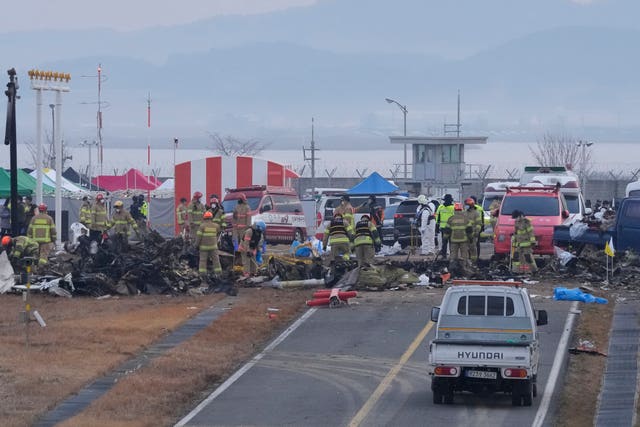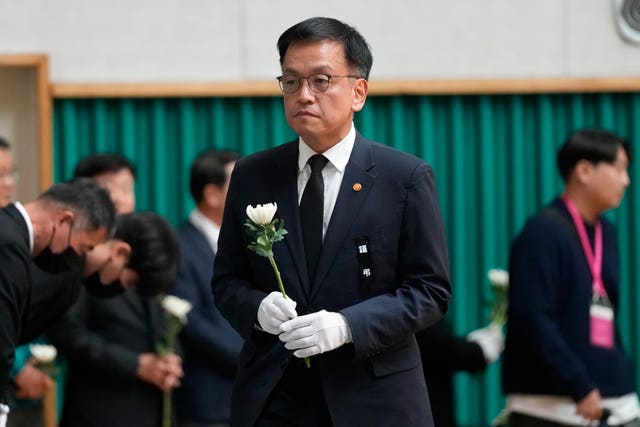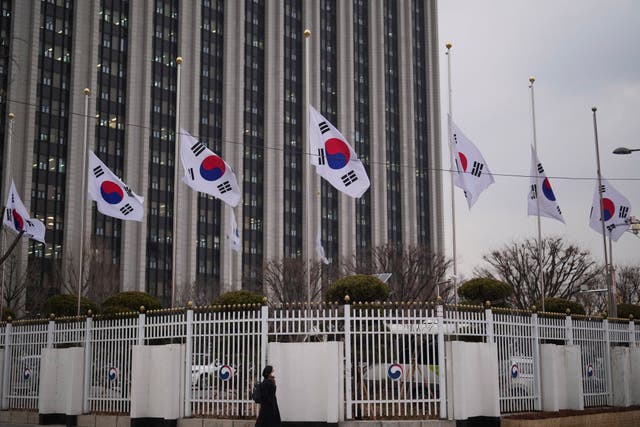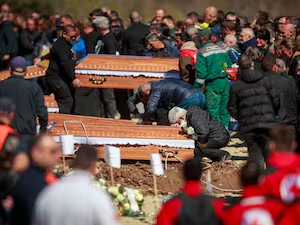South Korea to inspect Boeing planes amid bid to determine cause of fatal crash
The Boeing plane operated by South Korea’s budget airline Jeju Air skidded off a runway at Muan International Airport.

South Korean officials have said they will conduct safety inspections of all Boeing 737-800 aircraft operated by the country’s airlines, as they struggle to determine what caused a plane crash that killed 179 people.
Sunday’s crash, the country’s worst aviation disaster in decades, triggered an outpouring of national sympathy.
Many people worry how effectively the South Korean government will handle the disaster as it grapples with a leadership vacuum following the recent successive impeachments of President Yoon Suk Yeol and Prime Minister Han Duck-soo, the country’s top two officials, amid political turmoil caused by Mr Yoon’s brief imposition of martial law earlier this month.
New acting president Choi Sang-mok on Monday presided over a task force meeting on the crash and instructed authorities to conduct an emergency review of the country’s aircraft operation systems.

The Boeing 737-800 plane operated by South Korean budget airline Jeju Air aborted its first landing attempt for reasons that are not immediately clear.
Then, during its second landing attempt, it received a bird strike warning from the ground control centre before its pilot issued a distress signal. The plane landed without its front landing gear deployed, overshot the runway, slammed into a concrete fence and burst into a fireball.
Alan Price, a former chief pilot at Delta Air Lines and now a consultant, said the Boeing 737-800 is a “proven airplane” that belongs to a different class of aircraft than the Boeing 737 Max jetliner that was linked to fatal crashes in 2018 and 2019.
But South Korea’s Transport Ministry said on Monday it plans to conduct safety inspections of all of the 101 Boeing 737-800 jetliners operated by the country’s airlines as well as a broader review into safety standards at Jeju Air, which operates 39 of those planes.
Senior ministry official Joo Jong-wan said representatives from the US National Transportation Safety Board and Boeing were expected to arrive in South Korea on Monday to participate in the investigation.
Ministry officials also said they will look into whether a concrete fence at Muan Airport housing a set of antennas designed to guide aircraft safely during landings should have been made with lighter materials that would break more easily upon impact.

Video of the crash indicated that the pilots did not deploy flaps or slats to slow the aircraft, suggesting a possible hydraulic failure, and did not manually lower the landing gear, suggesting they did not have time, said John Cox, a retired airline pilot and chief executive of Safety Operating Systems in St Petersburg, Florida.
Despite that, the jet was under control and travelling in a straight line, and damage and injuries likely would have been minimised if not for the barrier being so close to the runway, Mr Cox said.
Other observers said the videos showed the plane was suffering from suspected engine trouble but the landing gear malfunction was probably a direct reason for the crash. They said there would not likely be a link between the landing gear problem and the suspected engine issue.
Earlier on Monday, another Boeing 737-800 plane operated by Jeju Air returned to Seoul’s Gimpo International Airport shortly after take-off when the pilot detected a landing gear issue.
Song Kyung-hoon, a Jeju Air executive, said the issue was resolved through communication with a land-based equipment centre, but the pilot decided to return to Gimpo as a precautionary measure.
Mr Joo said officials were reviewing whether there might have been communication problems between air traffic controllers and the pilot.
“Our current understanding is that, at some point during the go-around process, communication became somewhat ineffective or was interrupted, ahead of the landing and impact,” he said.

The Muan crash is South Korea’s deadliest aviation disaster since 1997, when a Korean Airlines plane crashed in Guam, killing 228 people on board.
The crash left many South Koreans shocked and ashamed, with the government announcing a seven-day national mourning period through to January 4.
The Transport Ministry said authorities have identified 146 bodies and are collecting DNA and fingerprint samples from the other 33.
The crash was yet more major news for South Koreans already reeling from a political crisis set off by Mr Yoon’s martial law decree, which brought hundreds of troops into Seoul streets and revived traumatic memories of past military rule in the 1970 and 80s.
The political turmoil resulted in the opposition-controlled National Assembly impeaching Mr Yoon and Mr Han. The safety minister stepped down and the police chief was arrested over their roles in the martial law enforcement.
The absence of top officials responsible for managing disasters has led to concerns.
“We are deeply worried whether the Central Disaster and Safety Countermeasures Headquarters really can handle the disaster,” the mass-circulation JoongAng Ilbo newspaper said in an editorial on Monday.





